From Udon to Mt. Fuji, Our Adventures in the Urban Jungles of Lactose-Intolerant Japan
- The land of efficiency, discipline, beauty, precision, technology, tradition and, of course, bidets.

The Land of the Rising Sun also turned out to be the land of the rising “son” in our case. My 16-year-old son who was the main reason for us to take this trip to Japan not only rose promptly every day but also guided us through the web of subways and underground streets and malls. Japan’s subway system is so efficient and punctual that we always end up showing up early to our activities. In fact, most commute happens below the surface, that too in several layers, keeping their roadways congestion-free. Otherwise, at nearly 40 million people, the greater Tokyo region would be impossible to live in. However, decoding their different lines, routes, floors, underground streets, and malls is no small feat for visitors. One rude awakening for us was that our two-dimensional GPS system was pretty much useless when we were underground.
The Japanese natural inclination is towards efficiency, discipline, beauty, precision, and tradition, in some order, however, opposites or extremes in each category not only co-exist but are mutually sustaining. Tradition and trends are equally important, anime is as vital as religion, and beauty and technology coexist. You will see that old traditions such as the Japanese bow are very much in use today (can I link that to their fitness?), but you will be surprised that freedom of expression is shown in the Harajuku style of dressing (saw some real-life Barbies). We visited as many temples and shrines as anime stores and entertainment hubs with dozens of characters. The delicate art of calligraphy which is still alive today is in strong contrast with the so-in-your-face technology and advertising done in bold colors, font, and music.
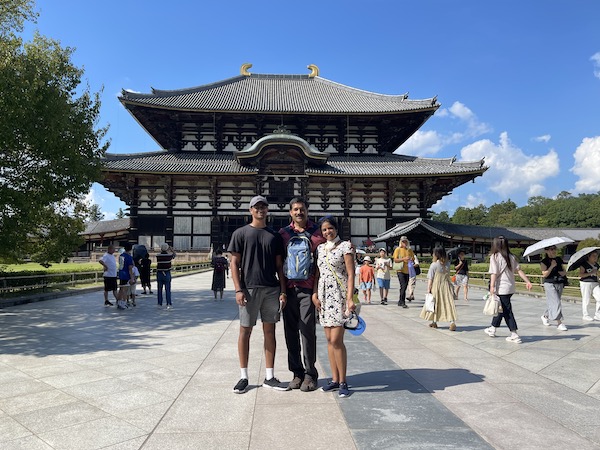
My excitement about dodging a typhoon narrowly was short-lived when I realized how hot Japan is in August. The temperatures were hitting triple digits on most days and we were bathing in our own sweat most of the time. Relief came in the form of the cooler subterranean train rides, walks, stores, and eateries that seemed to exist in most major cities in Japan, probably constructed to maximize space in a densely populated country. The hotel rooms in Tokyo are like matchboxes in size but clean and comfortable. Construction is like Barbie meets Lego, tiny dollhouses but Lego-like precision. My TP-obsessed American friends must learn about the Japanese toilet systems complete with bidets, which allow you to wash and clean after your business.

A Lactose-Intolerant Nation
Most Japanese people are lactose intolerant even today as dairy was not in the Japanese traditional diet. Other than the occasional softserve, you don’t see dairy as an option, and even their lattes are watered down with very little milk. Japanese people have glowing, acne-free skin because of low consumption of dairy but for bone growth in children and for prevention of osteoporosis in older women, it is recommended that they add more dairy, the necessary evil, to their diet.
The struggle with our first meal, I thought, was because of a learning curve. Much to my surprise and frustration, I learned I may never get there in Japan. Chicken dishes come with pork meat, pork broth, or seafood paste as a base, and my vegetarian options were boiled tofu, fermented miso, seaweed as a seasoning, many interesting-looking mushrooms, and matcha, their green tea which is pure chlorophyll, all difficult choices for my palate, and sometimes my other senses. Seafood menus include many more options than the usual fish, shrimp, and crab, and to me were more like exhibits at an aquarium. Let’s just say I had a difficult time with food but I know it’s me, not them. In fact, the Japanese diet is supposed to be good for your heart health and to maintain a healthy body weight (which is apparent as you hardly see any overweight people in Japan).

Eating is also a private matter and you see most restaurants with bar-style seating or personal spaces with partitions, especially in metro areas. I wondered if that was because of all the noisy slurping one has to resort to to suck in those noodles. Oh, I forgot to mention, I enjoyed noodles, udon, and ramen, whenever I could find them served in friendly broths, but fishing those noodles from warm bowls of broth with chopsticks, a feat as performed by me, may have looked awkward, uncivilized, and anti-social and may have shocked some unsuspecting passersby. Later, I learned from the locals that you can save your face by sticking your face close to the bowl as you do your business of noodle slurping.
Japanese are extremely polite and helpful, but also very formal, private, and socially a little awkward, and that is not just with eating. You will have total strangers coming over offering to help if needed but at the same time, you do not see subway commuters make eye contact with any strangers much less engage in small talk. This complete lack of curiosity from the locals towards an “alien” like me was surprising, shocking, and truth be told, a little offensive. Yes, I am too proud to accept that people are not interested in me.
A Tolerant People
In the 21st century, as we are dealing with conflicts over religion, it is commendable that Shintoism and Buddhism not only co-exist in Japan but a good majority of Japanese practice both. You will see as many Shinto shrines with bright orange torii gates as Buddhist temples with their Zen sanmon gates. The peaceful and quiet Meiji Jingu shrine contrasts with the loud and bustling Sensoji temple which happens to be the oldest temple in Tokyo. The Imperial Palace is the official residence of the Emperor and is situated in a large park with beautiful Japanese black pine trees.

Lunch that day was eventful as we transported ourselves to a Robot cafe (promised my Japan-crazy nephew I would visit for him), a restaurant where robots are in charge of serving customers. Our server, Robot Marie, inquired about our trip after serving us our drinks. After a leisurely afternoon at the Shinjuku Gyoen National Garden, we took a train to Shibuya Scramble, Tokyo’s Times Square. We had to check out the Pokemon store given Japan is its birthplace, before getting to the scramble crossing. Shibuya scramble crossing is a place where vehicles in all directions stop at the same time and over a thousand pedestrians cross each time. Tickets were sold out to get an aerial view but a Starbucks came to our rescue. After participating in the scramble ourselves, we got to our hotel rooms with aching feet, but hearts full.
Tokyo has it all figured out about being a big city. Everything is done on time, efficiently, and with precision, except for a few inconveniences. For such a technologically advanced nation, you still have a good number of situations, like the subway tickets, where you can only use cash for transactions, that, too, Yen. I was appalled that my dollars were of no use here. Also, you may need to carry your trash with you until you find trash bins which are rare but I noticed that the city collects trash every day, maybe because the houses are small. I was very grateful for the numerous 7-Eleven stores with tourist-friendly snack options which you find every few yards in some areas and train stations.
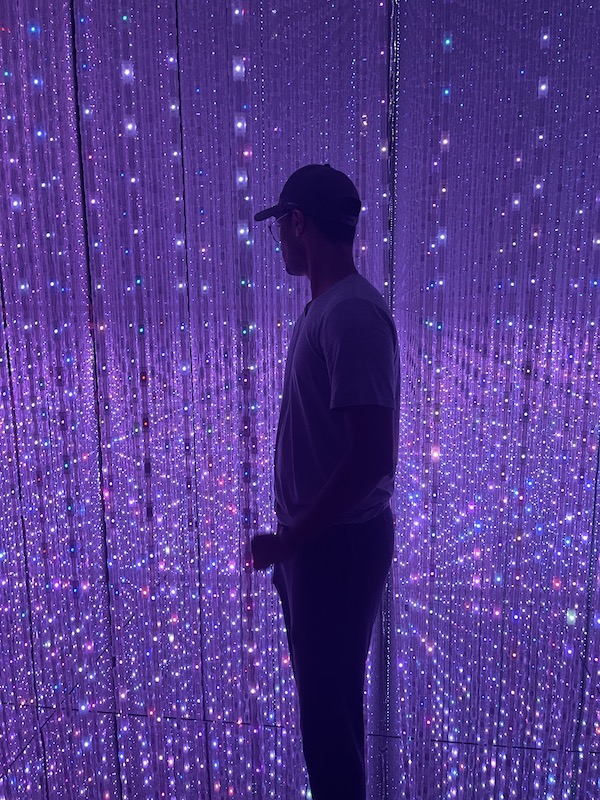
A Popular Suicide Spot
The next day was gloomy as we were passing through Aokigahara forest, a popular suicide spot in Japan. A sign has been placed urging people to seek help and not take their lives. My mood only got gloomier when it was still raining when we reached Mt. Fuji and we could not see the peak at all. The Ropeway to Owakudani Valley felt safe but the rain prevented us from seeing the volcanic activity closely. We had better luck with the boat ride on Lake Ashi and we even spotted an orange torii gate at a distance. We got to see the same gate closer when we visited the Hakone-jinja shrine on the shore later.
For a country leading in car manufacturing, Japan’s car ownership is much lower than the United States owing to limited parking space in metros. Given the superior public transit system in most cities, they may not miss having cars. Japanese may not have car ownership in their Japanese dream if there is one, but they sure contribute to the American Dream.
Odaiba, an artificial island in Tokyo Bay, primarily an entertainment hub, offers many options for all ages. Though we indulged ourselves in all kinds of fun activities in the futuristic Odaiba, the highlight was the Teamlab Planets experience. Their art displays include touch, sight, and sound but what is special about them is that they are interactive. I swear a fish swam away when I tried to touch it. The final activity in Tokyo was observing the city lights from the observation deck of Tokyo Skytree, which is the tallest tower in Japan at 634 meters.

The Shinkansen bullet train ride to Kyoto the next morning was smooth even at 320 kmph. Kyoto is a much smaller city than Tokyo but has hundreds of temples and shrines and is considered the cultural capital of Japan. I was surprised that Higashi Honganji temple, this large compound with multiple structures that we came across looking for food, was not even in our list of Kyoto highlights to visit. That evening we walked aimlessly through the streets of Gion, Kyoto’s geisha district, hoping for a chance encounter with a geiko or a maiko (geisha in training). We didn’t have much luck there but we found a good ramen place to fill our tummies.
The next day was like a pilgrimage with three large temples and shrines in the itinerary. The first one on the list, Fushimi Inari, is one of the many Shinto shrines, dedicated to Inari, the God of rice. We clearly underestimated the 2.5-mile trail and spent too much time taking pictures at the tower gate, the main hall, and Senbon Torii (rows of a thousand very colorful torii gates), and had to turn back before reaching the summit of Mount Inari. However, we were able to see several smaller shrines donated by Japanese businesses on the way back.
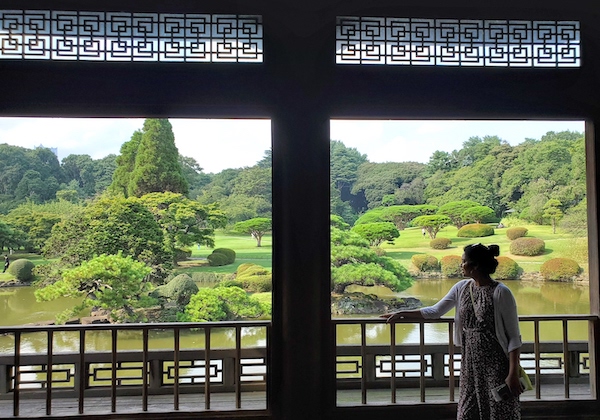
Kiyomizu Dera, nestled in the wooded hills, a Buddhist temple and a UNESCO World Heritage site is another beauty with gorgeous halls, verandas, and pagodas. We drank religiously from the Otowa waterfall, the pure water after which the temple was named. Our next stop, Kinkakuji temple, is covered in Gold leaf and is a sight to see, but I loved its reflection in the quiet pond even more. Arashiyama bamboo forest was beautiful but we were soaked in sweat by that time and had to call it a day after taking a few quick pictures.
Nijo Castle, which served as a residence and office for visiting shoguns (military officials serving the Emperor) is another UNESCO World Heritage site, Ninomaru Palace being the main attraction. The palace has several rooms that shoguns used to receive their visitors based on their ranks. The walls are adorned with kano paintings of pines, peacocks, and tigers on gold leaf and the squeak of the “nightingale” floors, even though meant for security, is pleasant to the ears.
A Floor Full of Ramen
The next activity is a tour of Nara, another city known for temples, but before that, I have to dedicate a paragraph or two to the Kyoto station. Yes, Kyoto station acts as a transportation hub and serves several train lines including the Shinkansen bullet train, city buses, and taxis, but what makes it special is that it is a 15 storied building, probably the largest I have ever seen, with options to shop, eat, and have fun. Here I am thinking how much more fun vacations would be if you had those kinds of options for entertainment and food as you are waiting for your transportation. Having an entire floor for restaurants is one thing, but another entire floor for just ramen noodles? The station also has an observation deck (from where you can observe the Kyoto Tower) and a skyway on the 11th floor.
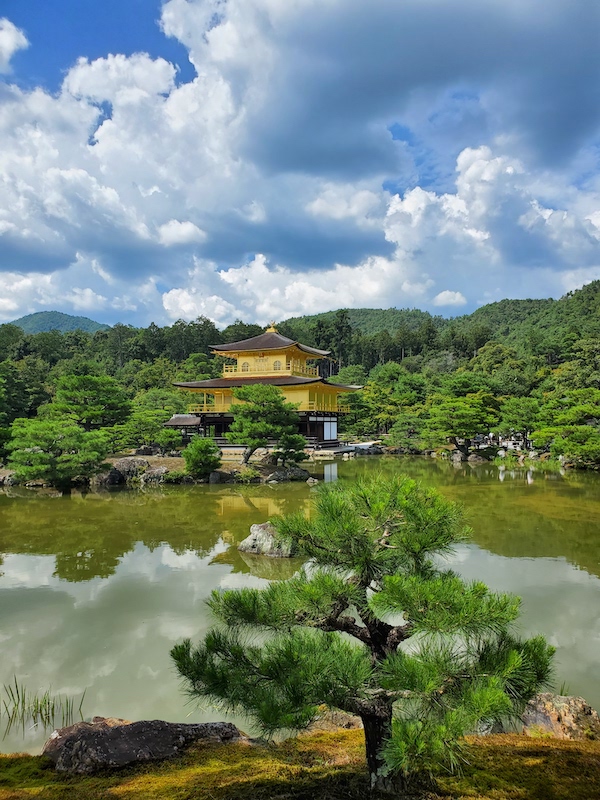
The Buddha statue at the Todaiji temple in Nara looked peaceful and powerful at the same time, maybe because of its size. But what I found interesting, and made the Indian in me a little proud, is the replica of the Asoka pillar and the four-headed lion statue in the temple. The deer at the Nara park show their respect by bowing to you but bully you for food right after, We only got to take pictures of Kofukuji temple on our way back to the station, as we spent too much time feeding crackers to the deer and ice cream to ourselves. Needless to say, we ate at the Kyoto station that day, at one of the Ramen restaurants.
Luckily for us, there were signs and instructions in English where we needed them. However, the amount of information (including advertisements) being thrown at you is everywhere and is overwhelming. I also learned that there are two scripts that Japanese use, kanji which is based on Chinese characters (each character a word), and the modern kana which is more syllabic. To my simple mind, they are both extremely beautiful but suitable more for calligraphy (and definitely not following the Lean and Six Sigma principles), than script.
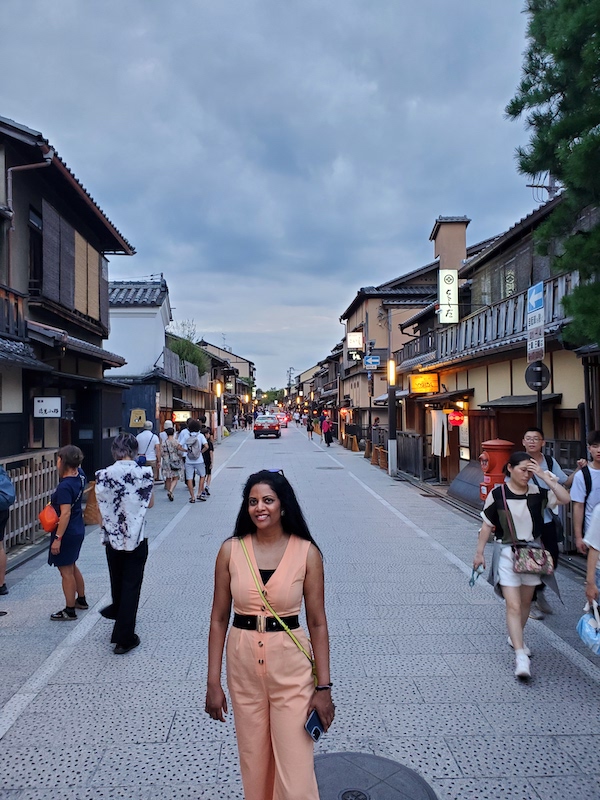
While Tokyo, being the capital, is a little formal and corporate, and Kyoto is about culture and religion, Osaka is all about food, fun, and shopping. Every station has underground malls that are interconnected, and unless you pay close attention, you may get lost. The good thing is you would not mind getting lost as long as you have your credit card on you. The only other thing we did on our first day in Osaka, other than shopping and eating, was to “observe” Osaka from the Umeda Sky building, the observatory tower that connects two 40-story buildings, another architectural marvel.
More “observing” happened the next day, again between more food and shopping, from the Osaka Castle and Abeno Harukas 300 Observatory. Osaka Castle is a green sanctuary in the middle of this otherwise urban jungle. Abeno Harukas is a 300-meter building with multiple observatory decks including the rooftop helipad. The views were breathtaking and the wind added to our experience. That night, my son and I got to check out the Teamlabs Osaka offerings, which provided a different experience than the one in Tokyo as it is set outdoors in a garden.
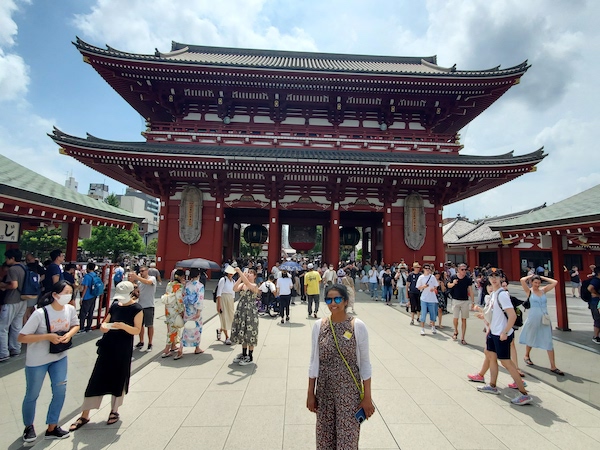
On our last day in Japan, we spent a good amount of time observing the residents of the Osaka Aquarium. The sharks seemed friendly from behind the glass enclosures, and I swear, a stingray even smiled at us, a very good experience I say. Walking in the well-lit, vibrant, bustling Dotonbori area alongside the canal that night was how we ended our trip. Times Square on steroids!
The world has one thing to learn from Japan — to work hard. And Japan has one thing to learn from the world — not to work so hard. Japanese show extreme dedication towards anything that they take up, and that is why everything they create ends up being popular, and they have a big list of those — the samurais and the shoguns, the geishas and the kimonos, sumo wresting and karate, the Pokemons and the Hello Kitties, the udons and the ramens, the sushi and teppanyaki, calligraphy and origami, the Toyotas and six sigma, and the list goes on. However, it is hard to believe that they all originated in this land of such humble people. Until next time, and there will be a next time, accept my humble bow. Sayonara Japan!
Padma Nadella is an IT professional who lives in Eagan, Minnesota with her husband and 15-year-old son. She manages a Facebook group for Minnesotans to collaborate on events and activities related to health and fitness. The group now has over two thousand members. Jack of all trades, she enjoys playing volleyball, traveling the world, and entertaining mostly but dabbles in everything else.


